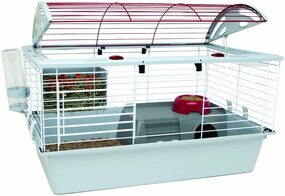Click HERE to go back to Basic Care
Chinchilla Cages
As I'm sure you have noticed by now, there are a lot of cages available to potential owners. Unfortunately, the majority of them are not safe/suitable for chinchillas. Many cages that were once deemed "safe" for chinchillas have fallen out of favor and new cages have taken their place on the recommendation list.
The majority of cages that can be purchased will come with ramps or platforms/ledges. Unless you have a chinchilla that is unable to jump onto ledges, you will not need any ramps. If you happen to have a chin requires ramps, they will either need to be solid metal, not made of plastic, OR be wire and kept properly covered with fleece AT ALL TIMES. Keeping a wire ramp covered will prevent their legs falling through and subsequently ending up with a possible broken leg.
Wire platforms/ledges are not suitable for being used with chins unless they are fully covered with fleece. I've seen (an heard of) a lot of chins with leg fractures and amputations that were a result of the use of these items (regardless of their spacing).
I would like to note that I have a personal preference of not recommending cages that have wire floors. Although many people (breeders and other rescues) feel that these are acceptable provided the chin has solid surfaces that it can rest on.
Midwest Ferret and Critter Nation Cages
The Ferret Nation and Critter Nation cages by MidWest have become the Gold Standard when it comes to chinchilla cages, they are also the cages that we use here at the rescue. As these are at the top of the recommendation lists, we will go more in-depth with these cages. Ferret Nations will be referred to as FN, while the Critter Nation will be referred to as CN.
Cage Versions
Currently, there are two different versions of both the CN and FN cages. The first versions required the entire cage to be screwed together, while the second (newer and current) version only requires the base be screwed together. While you can use a some parts interchangeably (such as trays, platforms, fleece covers, doors, wire floor, wheels, and stand wire/grate), for stacking purposes you will need to stick with one version or the other.
Ferret Nation

- 1" x 5" Vertical Bar Spacing
- Full-Width Double Doors
- Not suitable for babies or pregnant females
- Not personally recommended for homes with cats
- Weight-bearing bars on the outside of the horizontal bars
- Can add-on 1 or 2 additional cages, if desired.
- Price Range: $140 to $160 (single cage), $125 for an add-on
Critter Nation
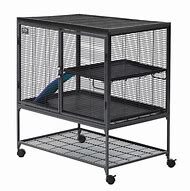
- Full-Width Double Doors
- 1/2" x 5 1/2" Horizontal Bar Spacing
- Suitable for babies or pregnant females
- Recommended for homes with cats
- Weight-bearing bars on the inside of the horizontal bars
- Can add-on 1 or 2 additional cages, if desired.
- Price Range: $150 to $175 (single cage), $140 for an add-on
Ferret Nation vs Critter Nation cages
There's minimal differences between the FN and CN. But those differences can have a huge impact on which cage you select and therefore any chin that subsequently lives in that cage. The most noticeable difference would be the wire spacing and how (what I call) the weight-bearing bars are attached. These bars are the ones that items, like wheels and most ledges, are typically attached to.
On the FN the vertical bars are the weight-bearing bars and are attached on the OUTSIDE of the horizontal bars. On the CN, the horizontal bars are the weight-bearing bars and they are attached on the INSIDE of the vertical bars. Why is this small quirk worth mentioning you may ask? Should you decide to use items that are decently weighty (like the chin-spin exercise wheels) there is a possibility of the weight-bearing bars on the CN cages detaching from the other bars. It's not very common, but it happens enough to make it worth mentioning. It's recommended that you add some additional support items to the outside of the cage (such as a piece of wood or metal).
Modular Design, Easy Add-On Sections
Due to the modular "pop-a-part" design of these cages they can be easily broken down for cleaning, storage, or transport. FYI, a Double Nation cage will fit in the trunk of a smaller vehicle like a Honda Accord. There is unfortunately a little bit of a learning curve when it comes to putting Nation cages together. However, once you get used to it, you can break down or put together a triple stack by yourself in about 5 minutes.
These cages are typically available as Single or Double units, however Midwest does also offer Add-On cages. While it's highly recommended that you do not exceed 3 cages tall, you can (with a little work and a few added safety items) do multiple side-by-side cages.
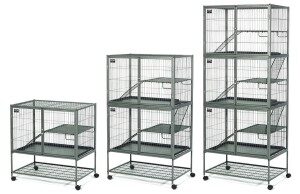
Trays with Fleece Liners, or Metal Pans
Nation cages, when purchased new, come with plastic trays and platforms that either need to be fully covered with fleece liners or replaced with metal trays and wood or metal ledges. Using bedding with the shallow plastic trays generally results in a chinchilla not being able to stay as clean as they should, a giant mess for you to vacuum up, and (most importantly) should these plastic trays fail to be covered or replaced your chin will have access to chew to their hearts content on the plastic.
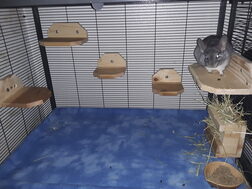
This cage has had accessories removed for the photo. Photo by OCR.
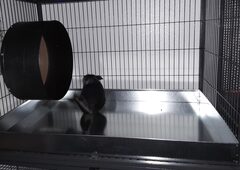
This cage has had ledges, accessories, and bedding removed for the photo. Photo by OCR.
Help keep that mess inside!
While Poop/Scatter Guards are recommended for these cages, I do not recommend the use of the ones offered by Midwest. This is due to the possibility of a chin being cut or otherwise injured. Chin-safe wood or metal guards that attach directly to the cage bars are the most recommended.
Help our information grow. If you can think of a possibly suitable cage, send a photo and name of it through our Contact Us page and we will do our best to list it accordingly.
Honorable Mention Cages
Please keep in mind that even though these cages are listed here people end up having to use these as "starter" cages because they typically need to be replaced within a few years after purchase. They generally always end up upgrading to a Nation Cage later. However, all all that being said, I have seen these cages used successfully when the necessary changes and/or modifications are made.
Poop/Scatter guards are recommended for ALL the bottoms and ledges/platforms of these cages, this will help to contain a large quantity of hay and poop that would otherwise get onto the floor. Furthermore, cleaning out the tray twice weekly (for a singles chinchilla) is highly recommended as hay will fall below the wire floor and build up. Once so much is built up, you will have issues pulling out the tray and it will end up creating a very large mess of hay/poop/bedding all over everything that's under the tray.
Prevue Critter Animal Cage
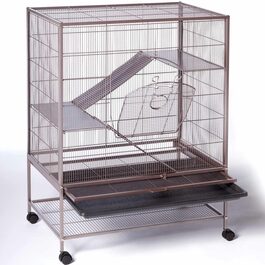
The Pros:
Room for a variety of accessories, lightweight for size, large front door, chew-proof ramp & platforms, 1/2" wire spacing, pull-out bottom floor, pull-out tray, and pretty stable when rolled around.
The Cons:
Door shape/size can make it difficult to get to a chinchilla, wire is very thin, weak, won't support much weight (like wheels or wooden ledges) and is prone to breaking, tray is thin, easily broke, and does not hold a lot of material as it's pretty shallow, and more than likely won't support any wheel, regardless of how light.
Pawhut and Ware Cages
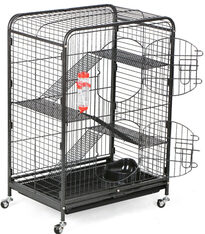 The Pros:
The Pros:
Size for 1 smaller chinchilla, wheels/frame don't tend to bend when wheeled around, 1/2" pull-out wire floor, 1/2" wire spacing, has wire ramps that aren't needed, and can support wood ledges dependent on size and weight.
The Cons:
Narrow for a cage, bars a bit thin, cannot use wire ramps or ledges, tray does not hold much material, ware variety comes with plastic ramps and platforms, gets tipsy when being rolled around, hard to get chin due to height and having 2 doors instead of 1 large, and big chins can break top bars loose. Cages taller than 2 doors are generally too high for a chinchilla.
Prevue/Hendryx Feisty Ferret
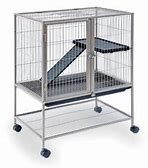
The Pros:
Single is okay for 1 small chinchilla, double is okay for 1 average chin, lightweight, can add on more sections, 7/8" wire spacing, pull-out tray, can support a very light wheel, and can support a few wood ledges, dependent on size and weight.
The Cons:
Frame by the wheels tend to warp/bend badly when rolled across the carpet, or over bumps, bars are a bit thin, comes with plastic platforms and ramps that would have to be replaced, and can't put much weight on the storage shelf.
Cages To Avoid For Chins
Pictures are for visual reference only. ALL cages, regardless of brand, that are constructed in this manner are not suitable for chins.
|
| 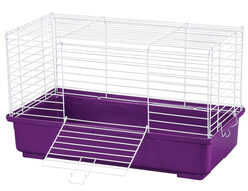 |
Certain Plastic-Based Cages
For clarification, this section is only referring to plastic-based cages that have the wire sitting on or attached to the top or ledge of the base and not those plastic-based cages that have the wire sitting on the inside (so that the chin has no chew access to the plastic). While I love these type of cages for other animals, they just don't meet the standards for chinchilla cages.
Regardless of how these cages are attached to the base of the chinchillas will chew the ledge of the plastic base which the wire sets upon, as well as any plastic pieces that attach the top of the cage to the base. Over time this will make the cage become very unstable and unsafe as the top of the cage will eventually start shifting/falling out of place. This can result in a whole variety of safety concerns, the most common being:
- Chin will try to escape, but have the cage part shift over onto their neck, causing injury, suffocation, or death.
- The cage part can fall off the base and whatever stand it was on, possibly resulting in injury or death.
- The can escape and be killed by another household pet, like a dog or cat.
- The chin can escape and chew on something toxic and it kills them.
- The chin can escape and chew on electrical cords and die as a result of electrocution.
Lightweight Bird/Sugar Glider Cages
It's sadly becoming more popular for people to go out and buy lightweight bird and sugar glider cages for chinchillas. This is unfortunately due to people on eBay (and other places) trying to sell these as chinchilla cages, when they are in fact not. It's particularly common for the flight cages (single, double, and triple) to be called chinchilla cages. While these cages have ample room and an attractive price, they are made for supporting lightweight perches, sticks, and other accessories for smaller animals, and not for supporting a chins heavy accessories (wheel and ledges). Over a short period of time the wires on the cage will generally bend and break. Aside from this, bird cages feature slide-up doors for quick access feeding, these turn into quick escape access for chinchillas.


Other Cages
Melamine/Wood Cages - These type of cages were recommended to us (and were all the rage) in the 2010's, and used positively by us and various other individuals/breeders. However, based on potential safety/health concerns this style of cage is no longer recommended.
